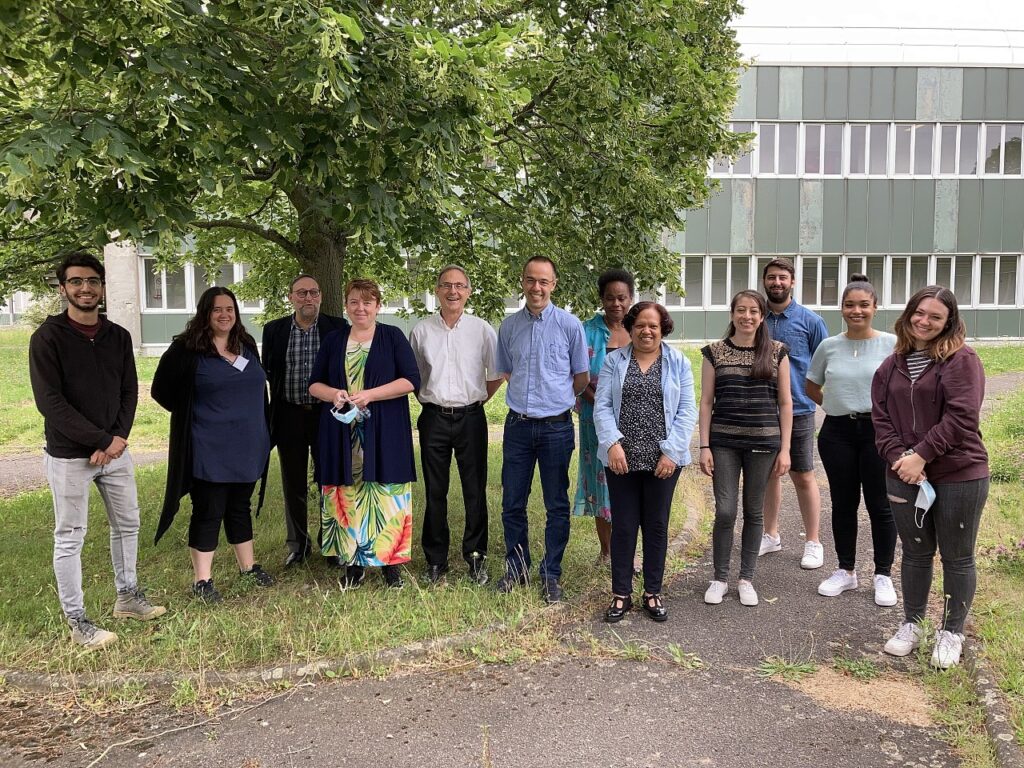Équipe 4 : Chimiothérapie Antiparasitaire – PARACHEM

Les membres de l’équipe

Les ANR
LeishmaStop
 The team « Antiparasite chemotherapy » (Philippe Loiseau) of the BioCIS research unit is one partner of the LeishmaStop project, managed by Julien Barbier (CEA Saclay) and selected within the Collaborative Research Project (PRC) call of the ANR (2018). Leishmaniases are a complex of parasitic diseases provoked by Leishmania protozoan parasites transmitted by the sandfly vector and affecting Humans and animals. The anti-leishmanial chemotherapy is expensive, aspecific therefore toxic, and drug resistance is usual or at risk. New treatments are urgently needed based on a rational chemotherapy. Parasites such as Leishmania successfully strive in host cells because they divert the intracellular trafficking machinery to maintain their parasitophorous vacuole in which they proliferate. We have identified inhibitors efficiently protecting cells against Leishmania infantum. Lead compounds were selected based on selective activity against intramacrophage amastigote forms as well as favorable physicochemical properties. In vivo proof of concept was confirmed with a derivative in a mouse model of infection. Further analogue selection on drugability criteria led us to identify one potential drug candidate with one back-up analogue that have physicochemical properties compatible with production of an easy to produce, low cost, standard pill for oral administration for the treatment of leishmaniasis. The ultimate goal of the project is to develop of a new class of oral anti-leishmanial drug, targeting components of the host’s intracellular machinery instead of targeting the parasites therefore reducing the risk of drug resistance acquisition by the parasites. Our objectives are to raise lead compounds development to TRL4 : a drug candidate and its backup ready for regulatory safety studies and clinical evaluation in infected leishmaniasis dog patients. To this end, we shall achieve : (1) Scale-up synthesis in a scheme compatible with pharmaceutical production ; (2) In depth physicochemical characterization of best crystal forms ensuring stability, solubility after oral administration and formulation ; (3) Radiolabeling and biodistribution of the parent drug and metabolites in mice ; (4) Determination dose and duration of treatment, acute and chronic toxicity evaluation ; (5) Pharmacokinetics, metabolites and pre-regulatory tolerance in dogs ; (5) Full identification, synthesis and antiparasite activity evaluation of main metabolites identified in dogs ; (6) Deciphering mechanism of protection of cells from parasite growth.
The team « Antiparasite chemotherapy » (Philippe Loiseau) of the BioCIS research unit is one partner of the LeishmaStop project, managed by Julien Barbier (CEA Saclay) and selected within the Collaborative Research Project (PRC) call of the ANR (2018). Leishmaniases are a complex of parasitic diseases provoked by Leishmania protozoan parasites transmitted by the sandfly vector and affecting Humans and animals. The anti-leishmanial chemotherapy is expensive, aspecific therefore toxic, and drug resistance is usual or at risk. New treatments are urgently needed based on a rational chemotherapy. Parasites such as Leishmania successfully strive in host cells because they divert the intracellular trafficking machinery to maintain their parasitophorous vacuole in which they proliferate. We have identified inhibitors efficiently protecting cells against Leishmania infantum. Lead compounds were selected based on selective activity against intramacrophage amastigote forms as well as favorable physicochemical properties. In vivo proof of concept was confirmed with a derivative in a mouse model of infection. Further analogue selection on drugability criteria led us to identify one potential drug candidate with one back-up analogue that have physicochemical properties compatible with production of an easy to produce, low cost, standard pill for oral administration for the treatment of leishmaniasis. The ultimate goal of the project is to develop of a new class of oral anti-leishmanial drug, targeting components of the host’s intracellular machinery instead of targeting the parasites therefore reducing the risk of drug resistance acquisition by the parasites. Our objectives are to raise lead compounds development to TRL4 : a drug candidate and its backup ready for regulatory safety studies and clinical evaluation in infected leishmaniasis dog patients. To this end, we shall achieve : (1) Scale-up synthesis in a scheme compatible with pharmaceutical production ; (2) In depth physicochemical characterization of best crystal forms ensuring stability, solubility after oral administration and formulation ; (3) Radiolabeling and biodistribution of the parent drug and metabolites in mice ; (4) Determination dose and duration of treatment, acute and chronic toxicity evaluation ; (5) Pharmacokinetics, metabolites and pre-regulatory tolerance in dogs ; (5) Full identification, synthesis and antiparasite activity evaluation of main metabolites identified in dogs ; (6) Deciphering mechanism of protection of cells from parasite growth.Actualités
Agents antileishmaniens ciblant le trafic de cellules hôtes
http://www.labex-lermit.fr/fr/recherche/projets/resistance/r3 Les leishmanioses sont un complexe de maladies parasitaires provoquées par des parasites à [...]




 Face aux défis liés à l’expansion mondiale des parasitoses, aux problèmes de toxicité, et de chimiorésistance pour bon nombre d’antiparasitaires actuels, une cinquantaine d’équipes de la métropole ou ayant une implantation outre-mer ont décidé de mettre leurs efforts en synergie dans une structure pluridisciplinaire : le Consortium AntiParasitaire (CAP), placé sous les auspices de la Société Française de Parasitologie. L’appartenance de ces laboratoires à divers organismes publics ou privés (INSERM, Institut Pasteur, CNRS, INRA, IRD, CHU, Grandes Ecoles, MNHN, universités, industrie, …) permettra au CAP de développer une forte interconnexion entre les structures de recherche académiques et industrielles.. Ce consortium aura pour mission prioritaire d’accélérer la découverte de nouveaux traitements antiparasitaires et d’en assurer l’accompagnement jusqu’en phase clinique. Le CAP rassemble ainsi des professionnels de l’innovation thérapeutique : parasitologistes, biochimistes, et modélisateurs pour la définition de cibles thérapeutiques, chimistes et pharmacognostes pour la conception et la synthèse de nouveaux principes actifs, galénistes pour leur formulation, cliniciens et épidémiologistes pour les essais cliniques et le suivi sur le terrain. Le CAP mènera son action aussi bien contre les ectoparasites comme les tiques que les endo-parasites (protistes et helminthes) qui ont un impact sur les économies sanitaires et agricoles en particulier dans les pays émergents ou en voie de développement. Le CAP se positionne comme une structure favorisant l’émergence de projets scientifiques novateurs mais favorise aussi l’implication des jeunes chercheurs en organisant des journées thématiques périodiques. Il interviendra aussi comme partenaire consultatif auprès des tutelles et/ou dans la mise en place d’appels à proposition dans le secteur de la chimiothérapie antiparasitaire.
Face aux défis liés à l’expansion mondiale des parasitoses, aux problèmes de toxicité, et de chimiorésistance pour bon nombre d’antiparasitaires actuels, une cinquantaine d’équipes de la métropole ou ayant une implantation outre-mer ont décidé de mettre leurs efforts en synergie dans une structure pluridisciplinaire : le Consortium AntiParasitaire (CAP), placé sous les auspices de la Société Française de Parasitologie. L’appartenance de ces laboratoires à divers organismes publics ou privés (INSERM, Institut Pasteur, CNRS, INRA, IRD, CHU, Grandes Ecoles, MNHN, universités, industrie, …) permettra au CAP de développer une forte interconnexion entre les structures de recherche académiques et industrielles.. Ce consortium aura pour mission prioritaire d’accélérer la découverte de nouveaux traitements antiparasitaires et d’en assurer l’accompagnement jusqu’en phase clinique. Le CAP rassemble ainsi des professionnels de l’innovation thérapeutique : parasitologistes, biochimistes, et modélisateurs pour la définition de cibles thérapeutiques, chimistes et pharmacognostes pour la conception et la synthèse de nouveaux principes actifs, galénistes pour leur formulation, cliniciens et épidémiologistes pour les essais cliniques et le suivi sur le terrain. Le CAP mènera son action aussi bien contre les ectoparasites comme les tiques que les endo-parasites (protistes et helminthes) qui ont un impact sur les économies sanitaires et agricoles en particulier dans les pays émergents ou en voie de développement. Le CAP se positionne comme une structure favorisant l’émergence de projets scientifiques novateurs mais favorise aussi l’implication des jeunes chercheurs en organisant des journées thématiques périodiques. Il interviendra aussi comme partenaire consultatif auprès des tutelles et/ou dans la mise en place d’appels à proposition dans le secteur de la chimiothérapie antiparasitaire.